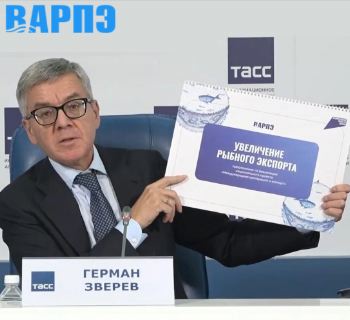|

German Zverev at the TASS Press Conference
VARPE Releases Strategic Report on Russian Fish Export Markets
 (RUSSIAN FEDERATION, 10/28/2024)
(RUSSIAN FEDERATION, 10/28/2024)
The global fish market is undergoing significant adjustments, according to German Zverev, President of the All-Russian Association of Fishery Industrialists (VARPE).
The association has conducted an in-depth study, titled “Markets and Products: Prospects for the Development of Fish and Seafood Exports by 2030,” which outlines opportunities and challenges for Russian fish and seafood exports by product category and geographical market. Zverev presented the findings at a TASS press conference on October 24, providing insights into how export dynamics may evolve over the next decade.
 FIS Seafood Media.png) The analysis takes a structured approach, examining 13 key product categories—including frozen pollock, cod, crab, horse mackerel, sardine, and herring—and four primary export markets: China, South Korea, Japan, and the European Union. These markets accounted for 90% of Russian fish export revenue in 2023. “We structured the study like a chessboard, assigning each product category to specific markets, then forecasting shifts over a six-year horizon,” Zverev explained. The projections are broken down into milestones for 2025 and 2027, assessing potential export volumes by market. The analysis takes a structured approach, examining 13 key product categories—including frozen pollock, cod, crab, horse mackerel, sardine, and herring—and four primary export markets: China, South Korea, Japan, and the European Union. These markets accounted for 90% of Russian fish export revenue in 2023. “We structured the study like a chessboard, assigning each product category to specific markets, then forecasting shifts over a six-year horizon,” Zverev explained. The projections are broken down into milestones for 2025 and 2027, assessing potential export volumes by market.
Zverev highlighted two major trends reshaping the fish export landscape. First, global trade restrictions are affecting Russia's ability to export to certain regions. “We are witnessing the rise of customs barriers and bans on Russian fish products in some countries,” he noted. Second, China’s diminishing role as the world's primary fish processing hub is prompting shifts in global supply chains.
VARPE predicts that the current volatility in global fish markets will persist for the next two to three years. By 2030, however, the market may stabilize into a more fixed structure that could endure for 10-15 years. One of the study’s key findings is the heightened risk associated with exports to countries imposing restrictive measures on Russian products. In response, Zverev emphasized the need to diversify Russia's export base: “Expanding the geographic reach of our exports is both crucial and achievable.”
The BRICS markets (Brazil, Russia, India, China, and South Africa) offer significant growth potential. Currently, about 50% of Russia’s seafood exports go to these countries, but VARPE anticipates that BRICS could absorb nearly two-thirds of exports in the future, especially as trade within the bloc strengthens. Zverev emphasized that developing product offerings, including high-value items as well as fresh, chilled, and live products, will enhance the appeal of Russian exports in these markets.

Forecasted Shifts in Export Destinations
The VARPE study outlines specific projections for Russian fish exports by 2030:
- European Union: The share of Russian fish and seafood exports is expected to decrease from 14.9% in 2023 (valued at $779.3 million) to 6.5% ($570.4 million).
- China: Exports could reach $4.88 billion, with an increased market share from 53.3% to 55%.
- South Korea: The market is forecasted to grow to $1.48 billion, with an increase in share from 15.3% to 16.7%.
- Japan: Exports may rise to $1.41 billion, boosting market share from 14.5% to 15.9%.
- Other regions: Exports to Africa, Latin America, and the Middle East may increase fivefold, potentially reaching $523.2 million.

Photo: TASS
Crab (in live, chilled, fresh, and frozen forms) and pollock are expected to remain Russia’s primary export items. VARPE projects that pollock and processed pollock products (such as surimi, fillet, and roe) could generate $1.6 billion, while various types of crab exports could reach $3.6 billion.
Industry Impact and Future Support
In total, VARPE estimates the potential for Russian fish and seafood exports to reach $8.85 billion by 2030. The association hopes the study’s findings will help support the goals set by Russian leadership to expand the country’s fish exports. Zverev expressed confidence that the data could inform targeted government support measures for the sector, which currently faces financial challenges: “The fishing industry’s economic position is strained, and this analysis provides a foundation to justify strategic and financial assistance where it’s needed most.”
This research underscores the importance of adaptive strategies in response to evolving trade environments, ensuring that Russian seafood products remain competitive and resilient in the global market.
[email protected]
www.seafood.media
Information of the company:
|
Address:
|
Christmas avenue, 9
|
|
City:
|
Moscow
|
|
State/ZIP:
|
(103045)
|
|
Country:
|
Russian Federation
|
|
Phone:
|
+7 495 252-10-45
|
|
E-Mail:
|
[email protected]
|
More about: 
|
|
|
|



